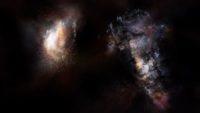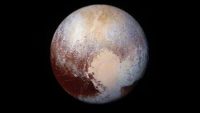By Rob Webb The expected benefits from the new NASA telescope, the naturalistic assumptions integrated into its mission, and the only way to make sense of scientific investigation: God. …read more Source: AIG Daily
By Dr. Danny R. Faulkner Why astronomers believe in an expanding universe, how the universe isn’t “expanding into” anything, and the reasons biblical creationists should be careful when arguing against the big bang …read more Source: AIG Daily
Are cratered planetary landscapes and moonscapes, and colliding galaxies, evidence against an Intelligent Designer? …read more Source: creation.com
By Dr. Danny R. Faulkner The big bang has been the dominant cosmogony for more than a half century, but the lithium measurements in the universe do not match the model. …read more Source: AIG Daily
There are countless interconnected, precise, and non-coincidental features of Earth that directly contribute to our planet’s ability to sustain life. One such phenomenon is that of Earth’s ultraviolet shield called the atmosphere. The atmosphere’s complex arrangement and seamlessly balanced, life-sustaining attributes distinctly indicate non-coincidental purpose and skillful crafting by a Designer who “is before all things… More… …read more Source: icr.org
By Spike Psarris Every year, the moon moves an inch or so farther away from earth. It may not seem like much, but that tiny movement puts a big limit on the moon’s age. …read more Source: AIG Daily
A recent article in Sky & Telescope magazine explains why secular theorists have difficulty agreeing on the ages of Saturn’s moons.1 In the process, the article provides a reminder that Saturn’s rings are young. It also presents possible evidence that some of Saturn’s moons are also young. Most important, it highlights the fact that (incorrect) secular origins stories spanning alleged histories of billion… More… …read more Source: icr.org
On June 7, 2021, NASA’s Juno spacecraft flew closer to Jupiter’s moon Ganymede than any spacecraft had ever before. Ganymede is the largest moon in the Solar System—a body larger than the planet Mercury. Its frozen surface holds interest as a distant water source. Analysts still ponder three unique features of Ganymede, one of which they’re now seeing for the first time. If reactions to youthful features on other bodies ou… More… …read more Source: icr.org
By Dr. Danny R. Faulkner Astronomers have detected water ~13 billion light-years away, which may be confirmation of biblical cosmology recorded in Genesis. …read more Source: AIG Daily
By Dr. Danny R. Faulkner How the first exoplanet outside our galaxy was discovered using a new technique to investigate deep space objects and what that means for life beyond the Milky Way …read more Source: AIG Daily
Has a planet really been discovered outside our galaxy? How could they find it? Could it support life? …read more Source: creation.com
By Ken Ham If a scientist writes an article suggesting God is the Creator of all things, he or she will not be published in any mainstream journal or science website. But the former chair of the astronomy department at Harvard University wrote an article suggesting our universe was designed, and he was published in Scientific American. Why? Because he suggested aliens created the universe! It’s certainly ok to propose fictional aliens creating the universe, but not God! Avi Loeb begins his article by stating, “the biggest mystery concerning the history of our universe is what happened before the big [More]
By Dr. Danny R. Faulkner Why Pluto’s atmosphere changes between perihelion and aphelion in its 248-year orbit around the sun and what that means for the age of the dwarf planet …read more Source: AIG Daily
Is the big bang compatible with God’s creation described in Genesis? …read more Source: creation.com
By Dr. Danny R. Faulkner We at Answers in Genesis have always maintained that the big bang model is incompatible with Scripture. …read more Source: AIG Daily
By Ken Ham Second millennium BC asteroid impact in the Dead Sea region does not closely align with the ancient cities’ locations in Genesis. …read more Source: AIG Daily
The Antikythera Mechanism has proven to be an astonishingly complex mechanical computer capable of predicting the planets positions contradicting evolutionary ideas of primitive ancient man …read more Source: creation.com
A star appears to explode faster than the cosmic speed limit. …read more Source: creation.com
On June 7, 2021, NASA’s Juno spacecraft flew closer to Jupiter’s moon Ganymede than any spacecraft had ever before. Ganymede is the largest moon in the Solar System—a body larger than the planet Mercury. Its frozen surface holds interest as a distant water source. Analysts still ponder three unique features of Ganymede, one of which they’re now seeing for the first time. If reactions to youthful features on other bodies ou… More… …read more Source: icr.org
By Dr. Danny R. Faulkner Comets can’t survive billions of years. …read more Source: AIG Daily
A naturalistic origin for these is not even in sight. …read more Source: creation.com
By Dr. Danny R. Faulkner The star Betelgeuse drastically faded in 2019, but now it’s back to its normal, bright self—what does that mean for stellar evolution or creation? …read more Source: AIG Daily
By Dr. Danny R. Faulkner Evidence now supports astronomers’ belief that the sun’s power comes from the fusion of hydrogen into helium deep in the sun’s core, but there is a huge problem. …read more Source: AIG Daily
Going, going, gone! Lessons from a disappearing planet. …read more Source: creation.com
A new study claims to have found the same amount of matter as the Big Bang predicted …read more Source: creation.com
Latest Cassini findings confirm a timeline too short for secular models of the solar system. …read more Source: creation.com
By Dr. Danny R. Faulkner Flat-earth proponents aim to demote gravity as a force, but they fail to account for time-honored conventions in physics informed by relativity. …read more Source: AIG Daily










































